
Izatha apodoxa is a moth of the family Oecophoridae. It is endemic to New Zealand, where it is known from scattered localities in the southern North Island. This species is variable in appearance and comes in two forms, a grey form and a black and white form. In the grey form it is very similar in appearance to I. notodoxa and in the black and white form to I. katadiktya. At present the larvae and biology of this species is unknown.

Izatha metadelta is a moth of the family Oecophoridae. It is endemic to New Zealand, where it is known from the North Island only. It is rare north of Waikato and the Bay of Plenty.

Izatha prasophyta is a moth of the family Oecophoridae. It is endemic to New Zealand, where it is known from the North Island, except Hawkes Bay or the Wairarapa. Larvae likely feed on rotting wood although larvae of this species have been reared on the fruiting body of the bracket fungus Bjerkandera adusta. Adults are on the wing from November to February.
Heterocrossa contactella is a species of moth in the family Carposinidae. It is endemic to New Zealand.
Heterocrossa epomiana is a species moth in the family Carposinidae. It is endemic to New Zealand.
Heterocrossa gonosemana is a species of moth in the family Carposinidae. It is endemic to New Zealand.
Petasactis is a genus of moths belonging to the family Tineidae. It contains only one species, Petasactis technica, which is endemic to New Zealand. This species has not been collected since prior to 1888. It is classified as "Data Deficient" by the Department of Conservation.

Pasiphila plinthina is a moth in the family Geometridae. It is endemic to New Zealand and is found in both the North, South and Stewart Islands. It is on the wing mainly from June until September with occasional observations up to December, and is attracted to light. This species is similar in appearance to P. sandycias but can be distinguished from it as P. plinthina has palpi that are longer and has more blurred forewing markings.
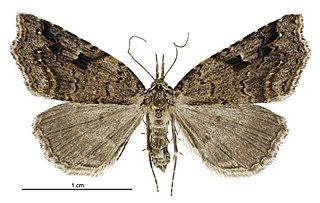
Trigonistis anticlina is a species of moth in the family Noctuidae. It is endemic to New Zealand. Adults of this species inhabit dense native forest habitat in ravines.

Chersadaula ochrogastra is a species of moth in the family Oecophoridae. This species is endemic to New Zealand. It is classified as "Data Deficient" by the Department of Conservation.

Kiwaia glaucoterma is a species of moth in the family Gelechiidae. It was described by Edward Meyrick in 1911. It is endemic to New Zealand.

Crypsitricha agriopa is a species of moth in the family Tineidae. It was described by Edward Meyrick in 1888. This species is endemic to New Zealand.

Crypsitricha pharotoma is a species of moth in the family Tineidae. It was described by Edward Meyrick in 1888. This species is endemic to New Zealand.
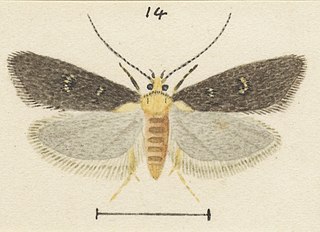
Trachypepla cyphonias is a species of moth in the family Oecophoridae. It is endemic to New Zealand and has been collected in Wellington and Taranaki. Larvae of this species have been reared from kānuka leaf litter. Adults are on the wing in December. This species is classified as "At Risk, Naturally Uncommon" by the Department of Conservation.
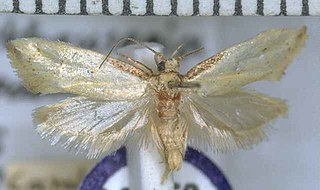
Tingena apanthes is a species of moth in the family Oecophoridae. It is endemic to New Zealand and found in the North Island. The adults are on the wing from October to December. It appears associated with Leptospermum species and it has been hypothesised that the appearance of the adults of this species imitates faded Leptospermum leaves.
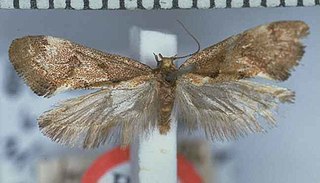
Tingena brachyacma is a species of moth in the family Oecophoridae. It is endemic to New Zealand and has been found in the south of the South Island. This species inhabits open swamps, native forest and scrubland and has been collected amongst Leptospermum. The adults of the species are on the wing in November and December.

Tingena hemimochla is a species of moth in the family Oecophoridae. It is endemic to New Zealand and has been observed in the North Island. Adults of this species are on the wing from December until March.

Tingena horaea is a species of moth in the family Oecophoridae. It is endemic to New Zealand and have been observed in both the North and South Islands. The adults are on the wing in January.
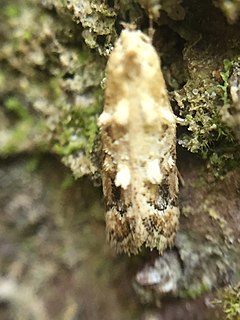
Trachypepla aspidephora is a species of moth in the family Oecophoridae. It is endemic to New Zealand and has been observed in the North and South Islands. Adults are on the wing from November to March and are attracted to light. The moths can be found resting on tree trunks where their colouration imitates lichens.

Trachypepla protochlora is a moth of the family Oecophoridae first described by Edward Meyrick in 1883. It is endemic to New Zealand and is found in both the North and South Islands. The preferred habitat of this species is native forest and adults are on the wing from October until February. Adults can be variable in their green shaded colour as well as in the intensity of markings on their forewings. The greenish ground colouration of this moth ensures they are well camouflaged when at rest on green mosses and lichens.
















